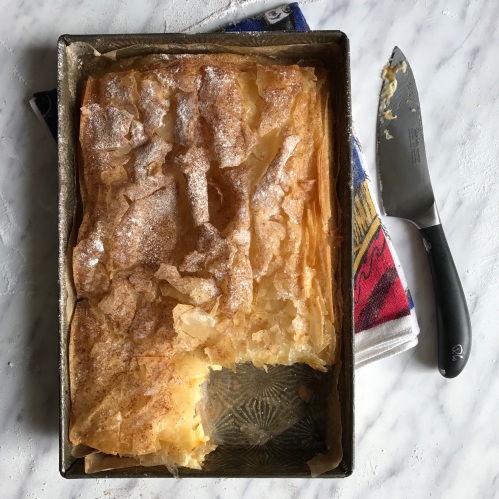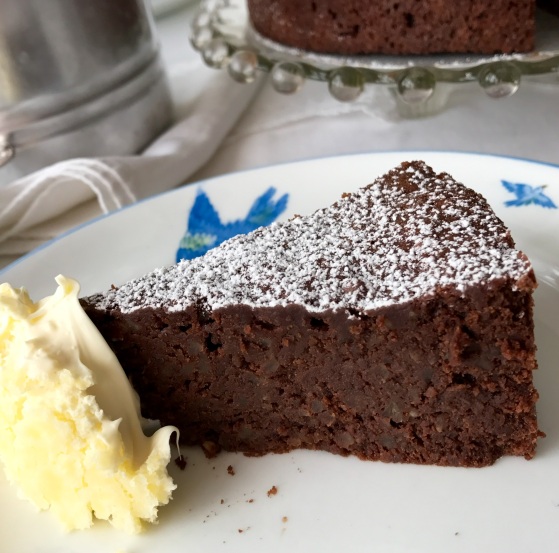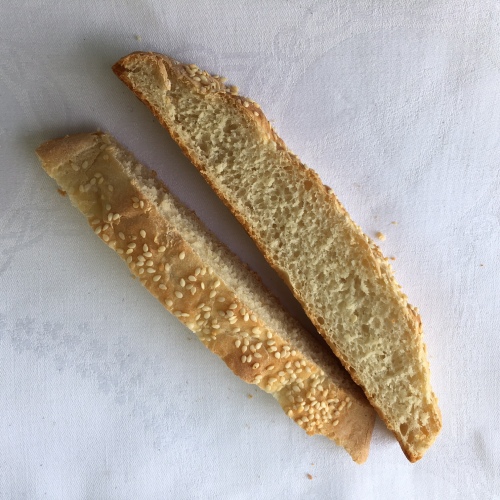
Galaktoboureko / Γαλακτομπούρεκο translated means milk pie. A bit of a mouthful of a name, it takes a little practice before it rolls off the tongue, unlike the pie which should melt in the mouth. A traditional Greek pastry that has an egg-rich, silky, creamy custard that is put to bed amongst crispy whisper-thin sheets of golden filo pastry. This is all coated and infused with a sweet, citrus scented syrup laced with heavenly notes of cinnamon. In the mouth, the crisp buttery pastry dissolves, allowing the delicate custard to flood the mouth like a soft gentle kiss on the forehead. I may sound rather lyrical about this dessert but it truly is a dessert fit for a Greek God. The name might be tricky but the recipe isn’t.
The best Galaktoboureko I have eaten was baked at my aunt’s home. Served warm, with the custard still light and wobbly and the filo pastry at the crisp melt in the mouth stage. I sat under the shade of a tree in her garden overlooking the azure crystal clear waters of the Mediterranean sea, a Greek coffee resting on my lap and the only thought in my head being whether could I manage a second slice.
Galaktoboureko is probably the first Greek dessert that comes to mind after Baklava and I know it isn’t always to everyone’s taste. The custard, traditionally made with semolina, can be grainy and rubbery often sitting between what can only be described as paper thin cardboard soaked in an syrup sweet enough to rot your fillings. I have eaten many versions of these and try to avoid them. Galaktoboureko does not really like to sit around for days on end. It is best enjoyed on the day. This recipe replaces the semolina used to thicken the milk with cornflour, getting rid of any grainy heavy texture that can occur. The cornflour also gives a much lighter delicate custard.
Galaktoboureko is usually made in catering sized trays which is more than I can ever eat so I have made a smaller version which has been adapted from the recipe of Stelios Parliaros. It can be baked either in a baking tray or in a spring form cake tin. I prefer spring form as makes it easier to portion up.
The only thing to remember is that the true secret to this recipe is creating the perfect alchemy in the syrup. Rosewater, lemon rind, orange rind and a cinnamon stick can be added to the sugar and water to create the thick sticky syrup but I prefer the simple flavours of lemon and cinnamon. The amounts and strength of flavour can be easily altered to suit but it can be equally delicious just coated in a plain sugar and water syrup.
Galaktoboureko 6-8 portions
Ingredients
350ml full fat milk
150ml double cream
seeds from 1 vanilla pod
40g cornflour
80g caster sugar
3 egg yolks
1 whole egg
100g butter (for brushing filo)
180g approx filo pastry (sheets)
syrup
250g sugar
150ml water
cinnamon stick
Strip of lemon zest
Oven 160C – Tray 27cms x 18cms or 21cm spring form cake tin
method
Place the milk and double cream into a pan. Add the vanilla seeds and little of the caster sugar – this will help to prevent the milk from catching on the bottom of the pan and burning. Gently bring the milk to the boil, stirring from time to time.
Combine the sugar and cornflour together in a bowl. Add the beaten eggs and with a whisk combine making sure that there are no lumps and the mixture is smooth and creamy.
Stir a little of the heated milk into the cornflour and eggs mixture and stir to combine, add a little more and stir then pour all of this mixture into the pan with the rest of the milk. Making sure there are no lumps and the mixture is smooth and creamy.
Replace the pan back on a low heat and continue to stir until the mixture has thickened. Remove and set aside.
Melt the butter.
Brush the cake tin all over with the melted butter and line with one sheet of filo, half in the tin and half outside. Carry on doing this, making sure to generously coat each sheet of filo with the melted butter.
Pour the custard into the tin and fold the filo sheets over the custard again brushing each with the melted butter.
Finally take a sheet of filo and brush with butter, fold in half and lay on top, repeat with a second sheet, tucking in any extra filo. This is to create a little extra height of filo layers. Give filo a final brush of butter and put into an oven for one hour.
Whilst the Galaktoboureko is in the oven make the syrup.
Put the sugar and water into a pan and heat until the sugar has dissolved. Best results are achieved by not stirring the syrup but by agitating the pan to stop the sugar sticking. Once melted add lemon rind and cinnamon stick and bring to a boil. Continue to boil for 10 minutes. Remove from heat and leave to cool. Swirling the pan every now and then making sure the syrup does not solidify.
The Galaktoboureko is done when the filo sheets are golden brown. Remove from the oven and little by little pour over the cooled syrup. Leave to cool. The syrup will be taken up by the Galaktoboureko as it cools. Best to leave for around an hour. The Galaktoboureko will still be warm.
Dust with icing sugar and ground cinnamon. Slice and serve maybe with a little ice cream.























 Usually in the middle of May, shortly after the May tree flowers, the elder tree will start to appear with large heads of creamy white froth. A signal that summer is nearly here. This year the weather has been awful and the seasons a little muddled. The elderflowers have been late. I have had to take several extra walks to check on progress. Then over a few days of sunshine small white buds started to appear and not long afterwards froths of flowers could be seen.
Usually in the middle of May, shortly after the May tree flowers, the elder tree will start to appear with large heads of creamy white froth. A signal that summer is nearly here. This year the weather has been awful and the seasons a little muddled. The elderflowers have been late. I have had to take several extra walks to check on progress. Then over a few days of sunshine small white buds started to appear and not long afterwards froths of flowers could be seen.






